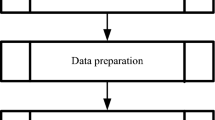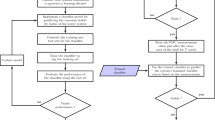Abstract
Fast and accurate online dynamic security analysis (DSA) is the key enabler for secure operation of modern power systems. Real-time assessment of the current power system operating state and increased awareness about plausible future insecurity can enable necessary operational and control measures to ensure secure operation. This paper proposes an ensemble decision tree (DT)-based online DSA method for large-scale interconnected power system networks using wide area measurement (WAMS) with phasor measurement units (PMU). A novel attribute selection method has been demonstrated for optimizing PMU installation at strategic buses in large-scale power networks. Multi-stage screening of the initial measurements has been done to minimize the data acquisition cost and computation overhead, which are the key challenges in real-time DSA. The ensemble DT classifier was trained offline using data from the operational model of the power system under different system loading and contingency conditions. The trained classifier provides online security assessment and classifies the power system’s current operating state as secure or insecure based on real-time measurements of the key attributes by selective PMUs. The proposed scheme was tested on IEEE 118-bus system, and the results demonstrate that it has the potential to be used as a reliable online DSA method.




Similar content being viewed by others
Availability of data and material (data transparency)
The data sets used and/or analysed during the current study are available from the corresponding author on reasonable request.
Code availability (software application or custom code)
The custom code used in the current study is available from the corresponding author on reasonable request.
References
Kundur P (1994) Power system stability and control. McGraw-Hill Education, New York
Kundur P, Paserba J, Ajjarapu V, Andersson G, Bose A, Canizares C, Hatziargyriou N, Hill D, Stankovic A, Taylor C, Cutsem VT, Vittal V (2004) Definition and classification of power system stability IEEE/CIGRE joint task force on stability terms and definitions. IEEE Trans Power Syst 19(3):1387–1401
Wehenkel L, Cutsem VT, Ribbens-Pavella M (1989) An artificial intelligence framework for online transient stability assessment of power systems. IEEE Trans Power Syst 4(2):789–800
Sauer WP, Pai AM (1998) Power system dynamics and stability. Prentice-Hall, New Jersey
Laufenberg JM, Pai AM (1998) A new approach to dynamic security assessment using trajectory sensitivities. IEEE Trans Power Syst 13(3):953–958
Chang DH, Chu CC, Cauley G (1995) Direct stability analysis of electric power systems using energy functions: theory, applications, and perspective. Proc IEEE 83(11):1497–1529
Chiang DH, Wang SC, Li H (1999) Development of BCU classifiers for on-line dynamic contingency screening of electric power systems. IEEE Trans Power Syst 14(2):660–666
Zhang R, Xu Y, Dong YZ, Wong PK (2015) Post-disturbance transient stability assessment of power systems by a self-adaptive intelligent system. IET Gener Transm Distrib 9(3):296–305
Fouad A, Vittal V (1988) Power system transient stability analysis using the transient energy function method. Int J Electr Power Energy Syst 10(4):233
Hiskens I, Hill D (1989) Energy functions, transient stability and voltage behaviour in power systems with nonlinear loads. IEEE Trans Power Syst 4(4):1525–1533
Morteza S, Wu EN, Bay SJ (2018) Transient stability assessment of large lossy power systems. IET Gener Transm Distrib 12(8):1822–1830
Chiang DH, Li H, Tong J (2013) On-line transient stability screening of a practical 14,500-bus power system: methodology and evaluations. High performance computing in power and energy systems. Springer, Berlin, pp 335–358
Hansen KL, Salamon P (1990) Neural network ensembles. IEEE Trans Pattern Anal Mach Intell 12(10):993–1001
Kamwa I (2010) Catastrophe predictors from ensemble decision-tree learning of wide-area severity indices. IEEE Trans Smart Grid 1(2):144–158
He M, Zhang J, Vittal V (2012) A data mining framework for online dynamic security assessment: decision trees, boosting, and complexity analysis. In: Proceedings of IEEE PES Innovative Smart Grid Technologies, ISGT 2012
Yan R, Geng G, Jiang Q, Li Y (2019) Fast transient stability batch assessment using cascaded convolutional neural networks. IEEE Trans Power Syst 34(4):2802–2813
Tan B, Yang J, Tang Y, Jiang S, Xie P, Yuan W (2019) A deep imbalanced learning framework for transient stability assessment of power system. IEEE Access 7:81759–81769
Hu W, Zongxiang L, Shuang W, Weiling Z, Yu D, Rui Y, Baisi L (2019) Real-time transient stability assessment in power system based on improved SVM. J Modern Power Syst Clean Energy 7(1):26–37
Gupta A, Gurrala G, Sastry SP (2019) An online power system stability monitoring system using convolutional neural networks. IEEE Trans Power Syst 34(2):864–872
Zhu Q, Chen J, Zhu L, Shi D, Bai X (2018) A deep end-to-end model for transient stability assessment with PMU data. IEEE Access 6:65474–65487
Zhu L, Hill JD, Lu C (2020) Hierarchical deep learning machine for power system online transient stability prediction. IEEE Trans Power Syst 35(3):2399–2411
Rovnyak S, Kretsinger S, Thorp J, Brown D (1994) Decision trees for real-time transient stability prediction. IEEE Trans Power Syst 9(3):1417–1426
Banfield R, Hall L, Bowyer K, Kegelmeyer W (2007) A comparison of decision tree ensemble creation techniques. IEEE Trans Pattern Anal Mach Intell 29(1):173–180
Jana S, De A (2020) Structured approach to downsize data administration and improve fault recognition accuracy for large power systems. IET Gener Transm Distrib 14(14):2731–2739
Chiang DH, Wu FF, Varaiya PP (1988) Foundations of the potential energy boundary surface method for power system transient stability analysis. IEEE Trans Circuits Syst 35(6):712–728
Geeganage J, Annakkage DU, Weekes T, Archer AB (2015) Application of energy-based power system features for dynamic security assessment. IEEE Trans Power Syst 30(4):1957–1965
Mason L, Baxter J, Bartlett LP, Frean RM (1999) Boosting algorithms as gradient descent. Neural information processing systems. Springer, Berlin, pp 512–518
Niculescu-mizil A, Caruana R (2005) Obtaining calibrated probabilities from boosting. In: Proceedings of 21st Conference Uncertainty in Artificial Intelligence, AUAI Press
Freund Y, Schapire R (1997) A decision-theoretic generalization of on-line learning and an application to boosting. J Comput Syst Sci 55:119–139
Kaplan (2019) PSAT/NMSQT Prep 2019: 2 Practice Tests + Proven Strategies + Online (Kaplan Test Prep)
Powertech Labs, DSATools: Dynamic Security Assessment Software. http://www.dsatools.com
Sun K, Likhate S, Vittal V, Kolluri V, Mandal S (2007) An online dynamic security assessment scheme using phasor measurements and decision trees. IEEE Trans Power Syst 22(4):1935–1943
Diao R, Sun K, Vittal V, Keefe OR, Richardson M, Bhatt N, Stradford D, Sarawgi S (2009) Decision tree-based online voltage security assessment using PMU measurements. IEEE Trans Power Syst 24(2):832–839
Zonoobi D, Kassim AA, Venkatesh VY (2011) Gini index as sparsity measure for signal reconstruction from compressive samples. IEEE J Sel Top Signal Process 5(5):927–932
Shang W, Qu Y, Huang H, Zhu H, Lin Y, Dong H (2010) Complete gini-index text (GIT) feature-selection algorithm for text classification. In: 2nd international conference on software engineering and data mining, SEDM 2010
He M, Zhang J, Vittal V (2013) Robust online dynamic security assessment using adaptive ensemble decision-tree learning. IEEE Trans Power Syst 28(4):4089–4098
Setiono R (2001) Feedforward neural network construction using cross validation. IEEE Trans Neural Comput 13(12):2865–2877
Ding H, Li G, Dong X, Lin Y (2018) Prediction of pillar stability for underground mines using the stochastic gradient boosting technique. IEEE Access 6:69253–69264
Mukherjee I, Rudin C, Schapire ER (2013) The rate of convergence of AdaBoost. J Mach Learn Res 14(1):2315–2347
Ohsaki M, Matsuda K, Wang P, Katagiri S, Watanabe H (2015) Formulation of the kernel logistic regression based on the confusion matrix. In: 2015 IEEE congress on evolutionary computation, pp 2327–2334
Gomez F, Rajapakse A, Annakkage U, Fernando I (2011) Support vector machine-based algorithm for post-fault transient stability status prediction using synchronized measurements. IEEE Trans Power Syst 26(3):1474–1483
Lilley WR (1990) Demonstration of MLS advanced approach technique. IEEE Aerosp Electron Syst Mag 5(5):41–46
Xu W, Nandi KA, Zhang J (2003) Novel fuzzy reinforced learning vector quantisation algorithm and its application in image compression. IEE Proc Vis Image Signal Process 150(5):292
Franti P, Kaukoranta T, Sen FD, Chang SK (2000) Fast and memory efficient implementation of the exact PNN. IEEE Trans Image Process 9(5):773–777
Aghamohammadi RM, Mahdavizadeh F, Bagheri R (2009) Power system dynamic security classification using Kohenen neural networks. In: IEEE/PES power systems conference and exposition
Acknowledgements
Not applicable.
Funding
The authors declare that they have not availed any funding from any source for this research work.
Author information
Authors and Affiliations
Contributions
All the authors participated and contributed equally in the analysis and interpretation of the results and data, drafting the article or revising it critically and preparing the final version.
Corresponding author
Ethics declarations
Conflicts of interest
The authors declare that they have no competing interests.
Additional information
Publisher's Note
Springer Nature remains neutral with regard to jurisdictional claims in published maps and institutional affiliations.
Appendix
Rights and permissions
About this article
Cite this article
Mukherjee, R., De, A. Real-time dynamic security analysis of power systems using strategic PMU measurements and decision tree classification. Electr Eng 103, 813–824 (2021). https://doi.org/10.1007/s00202-020-01118-z
Received:
Accepted:
Published:
Issue Date:
DOI: https://doi.org/10.1007/s00202-020-01118-z





